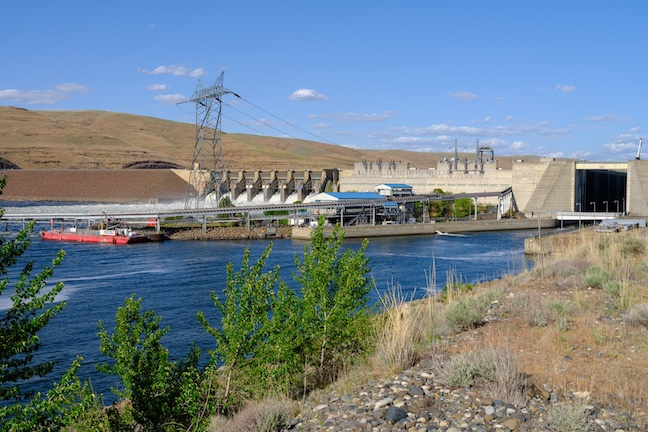forum
library
tutorial
contact

Group Says Snake River Remains
Listed Among 'Most Endangered'
by Staff
Idaho Press, April 18, 2023
|
the film forum library tutorial contact |

|
Group Says Snake River Remains
by Staff
|
Prior to dam construction, rail systems provided transportation
for agricultural products and could be built out once again.
 The number of salmon returning to the river each year used to be between 2 million and 6 million, and had dropped even prior to the completion of the dams in 1975. Today, that number is in the thousands.
The number of salmon returning to the river each year used to be between 2 million and 6 million, and had dropped even prior to the completion of the dams in 1975. Today, that number is in the thousands.
As tribes and environmental groups have sounded the alarm, political representatives have started listening. In 2021, after consulting a wide swath of northwest stakeholders, Idaho Congressman Mike Simpson proposed the Columbia Basin Initiative, a sweeping plan to remove the four Snake River dams and develop alternative infrastructure, arguing that it is one of the best opportunities to rescue salmon populations.
Shannon Wheeler, Vice Chairman of the Nez Perce Tribe, said the decision by American Rivers' leadership to relist the river will continue to raise awareness of its plight.
"Having it again on the most endangered list helps people recognize that issues haven't gone away; they're still there and something needs to be done," Wheeler said.
The issue is deeply personal to the Nez Perce, whose creation story holds that a salmon gave its life to help the tribe survive. However, when it did so, it gave up its voice in exchange for the tribe ensuring its protection going forward.
The tribe has carried that story, passed down orally from generation to generation, for thousands of years knowing that it would one day need to speak for salmon, Wheeler said.
"At this point in time, we are having to be the voice, and we understand why that creation story was told and why it was carried on and the importance of it," he said.
Wheeler said removing the dams and ensuring the future of Snake River salmon is about honoring the U.S.'s treaty with the Nez Perce, and improving economic opportunities for everybody.
"We are here to hold our hand out to the federal government and say we're here to help in any way to ensure that these species do not go extinct," Wheeler said, adding that it is possible to save salmon.
Leaders agreed that there is hope for the river given growing awareness and an unprecedented level of federal funding available.
Smith, American Rivers' Snake River director, estimated that the country has about 10-20 years to address the issue before extinction occurs. With Congress's passage of the Bipartisan Infrastructure Law last year, and growing political buy-in, including President Biden, Washington Gov. Jay Inslee, and Washington Sen. Patty Murray, there is more momentum than ever to get the job done, he said.
The dams generate some electricity, hold back irrigation water, and create a series of slow-moving sections of river that allows for barges to transport grain and other agricultural products to ports downstream. Leaders at American Rivers would like to see the federal government take the lead on developing alternative infrastructure.
For example, prior to dam construction, rail systems provided transportation for agricultural products and could be built out once again, he said.
Smith encouraged those interested in learning more about the issues to do their own research, including reading up on studies of costs and impacts to the local economy. And from there, he would encourage discussing the issue with local leaders, including county commissioners.
"This isn't just about salmon extinction," Smith said. "This is about helping rural economies grow and thrive in the next generation with a forward-looking vision instead of entrenched views around the status quo and not doing anything to change or help our economies and communities in the next generation and into the next century."
Stephen Pfeiffer, a conservation associate with Idaho Rivers United, noted that there may be unexpected opportunities associated with removing the dams. He pointed to the half-million acre-feet of water that Idaho sends downstream for spill at the Columbia River dams. Spill water, which is released over the top of dams rather than through it, appears to increase the survival of young salmon by helping them bypass dam turbines that could injure or kill them.
But the water would not necessarily need to be used for that purpose if the dams were removed, Pfeiffer said.
"That's water that if dams were removed and salmon were recovered, we could keep in Idaho and we could use to replenish our aquifer and aid agriculture in the upper Snake River basin," he said.
Pfeiffer echoed the need for people to talk to their friends, family, and political representatives about the issue.
"I think those conversations are important, and then directly reaching out to representatives, Gov. (Brad) Little ... elected leaders that have said, 'yes, of course, everyone wants to recover salmon,' but have kind of shirked away from addressing the big issues like (dam) removal that the science shows are absolutely necessary," Pfeiffer said.
learn more on topics covered in the film
see the video
read the script
learn the songs
discussion forum
